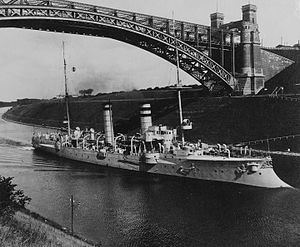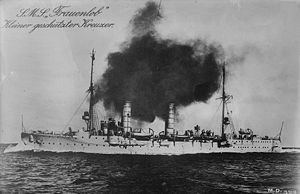Name Frauenlob Commissioned 17 February 1903 Construction started 1901 Length 105 m Displacement 3.158 million kg | Laid down 1901 Draft 4.99 m (16.4 ft) Launched 22 March 1902 Weight 3,158 tons Beam 12 m | |
 | ||
Class and type Gazelle-class light cruiser | ||
SMS Frauenlob ("His Majesty's Ship Frauenlob") was the eighth member of the ten-ship Gazelle class, built by the Imperial German Navy. She was built by the AG Weser dockyard in Bremen, laid down in 1901, launched in March 1902, and commissioned into the High Seas Fleet in February 1903. Armed with a main battery of ten 10.5 cm (4.1 in) guns and two 45 cm (18 in) torpedo tubes, Frauenlob was capable of a top speed of 21.5 knots (39.8 km/h; 24.7 mph).
Contents

Frauenlob spent her entire career in the reconnaissance forces of the High Seas Fleet. She saw action during World War I at the Battle of Heligoland Bight in August 1914, where she badly damaged the British cruiser HMS Arethusa, and at the Battle of Jutland on 31 May 1916. There, in a chaotic night engagement, Frauenlob was hit by a torpedo launched by HMS Southampton, which caused the ship to capsize and sink with the vast majority of her crew. The wreck was discovered in 2000, and is in remarkably good condition, sitting upright on the ocean floor.

Construction
Frauenlob was 105 meters (344 ft) long overall and had a beam of 12.4 m (41 ft) and a draft of 4.99 m (16.4 ft) forward. She displaced 3,158 t (3,108 long tons; 3,481 short tons) at full combat load. Her propulsion system consisted of two triple-expansion engines manufactured by AG Weser. They were designed to give 8,000 shaft horsepower (6,000 kW), for a top speed of 21.5 knots (39.8 km/h; 24.7 mph). The engines were powered by eight coal-fired Marine-type water-tube boilers. Frauenlob carried 700 tonnes (690 long tons) of coal, which gave her a range of 4,400 nautical miles (8,100 km; 5,100 mi) at 12 knots (22 km/h; 14 mph). She had a crew of 14 officers and 256 enlisted men.
The ship was armed with ten 10.5 cm SK L/40 guns in single mounts. Two were placed side by side forward on the forecastle, six were located amidships, three on either side, and two were placed side by side aft. The guns could engage targets out to 12,200 m (40,000 ft). They were supplied with 1,500 rounds of ammunition, for 150 shells per gun. She was also equipped with two 45 cm (17.7 in) torpedo tubes with five torpedoes. They were submerged in the hull on the broadside. The ship was protected by an armored deck that was 20 to 25 mm (0.79 to 0.98 in) thick. The conning tower had 80 mm (3.1 in) thick sides, and the guns were protected by 50 mm (2.0 in) thick shields.
History
Frauenlob was ordered under the contract name "G" and was laid down at the AG Weser shipyard in Bremen in 1901 and launched on 22 March 1902, after which fitting-out work commenced. She was commissioned into the High Seas Fleet on 17 February 1903. She was named for the schooner Frauenlob, launched in 1853, that had been paid for in part by the donations of women from the German lands; the name means "praise women." After her commissioning, Frauenlob was assigned to the fleet reconnaissance forces, where she served for the duration of her career. In 1905, she was assigned to the Cruiser Division, alongside her sister Arcona and the cruisers Hamburg and Friedrich Carl.
Frauenlob was recommissioned into the fleet on 2 August 1914, as a result of the outbreak of World War I. On 28 August 1914, Frauenlob saw her first action in the Battle of Heligoland Bight. The British Harwich Force, composed of two light cruisers and 33 destroyers under Commodore Reginald Tyrwhitt, raided the German picket line in the Heligoland Bight. Frauenlob was stationed to the southwest of the island of Heligoland in support of the picket line. At about 09:00, Frauenlob and the light cruiser Stettin were sent out to reinforce the beleaguered German patrols.
Frauenlob shortly thereafter encountered the British cruiser HMS Arethusa and opened fire at 09:09. She quickly found the range and hit the British ship an estimated 25–35 times, disabling all but one of her guns and inflicting serious damage. One shell detonated a cordite charge and set Arethusa on fire. The ship's engine room flooded and her speed fell to 10 kn (19 km/h; 12 mph). She turned away to starboard in order to escape from the punishing fire, but Frauenlob kept up with the badly damaged British cruiser until she disappeared in the fog. In return, Frauenlob was hit ten times, but was not seriously damaged; in all, five men were killed and another thirty-two were wounded. After the engagement ended, Frauenlob took the badly damaged minesweeper T33 under tow and returned her to Heligoland, before proceeding to Wilhelmshaven.
By the Battle of Jutland, on 31 May – 1 June 1916, Frauenlob was assigned to the IV Scouting Group, under the command of Commodore Ludwig von Reuter, which was tasked with screening for the High Seas Fleet. She was not actively engaged in the battle until later on the evening of 31 May; at around 9:15, the IV Scouting Group encountered the British 3rd Light Cruiser Squadron and briefly engaged them, but due to the poor visibility, only Stettin and München fired for long, and to no effect.
Later, during the chaotic night fighting, the battlecruisers Seydlitz and Moltke passed too closely in front of Stettin, which forced the entire Scouting Group to fall out of line, inadvertently bringing them into contact with the 2nd Light Cruiser Squadron. A ferocious firefight ensued, at a range of only 730 meters (2,400 ft). Frauenlob opened fire on HMS Southampton and HMS Dublin, as did the rest of the IV Scouting Group. In return, Southampton launched a torpedo that struck Frauenlob at around 22:35, which cut her power and caused serious flooding. British 6-inch (150 mm) shellfire set the deck alight, and the stricken cruiser quickly capsized and sank, taking twelve officers and 308 men down with her. Only 9 men from her crew survived.
Wreck
In 2000, the wreck was located by Danish divers. The British marine archeologist Innes McCartney led a subsequent dive and confirmed that the wreck sits upright on the sea floor and is largely intact. Skeletal remains from the ship's crew are scattered around the sunken cruiser. The wreck was positively identified when McCartney's team recovered the ship's bell in 2001, which they donated to the Laboe Naval Memorial near Kiel, where the bell is currently on display.
